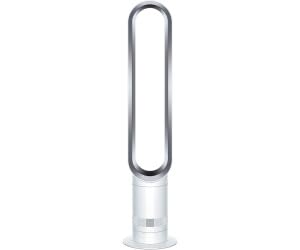How much does it cost to run a fan? I'm a HVAC pro and the answer to this question will help lower your bills
Finding out the cost to run a fan will help you save dollars and energy


You might be wondering the cost to run a fan, if you want to keep cool without using as much energy as turning on the AC.
Understanding this and how to optimize your fan's efficiency can help you save even more on your energy bills. I'm a HVAC technician, and I've written this detailed guide to help you calculate these costs, assess your fan's efficiency, and offer tips rooted in my years of experience on how to make your fan more energy-efficient.
In my experience, Dyson and Vornado offer some of the best fans on the market, but whichever one you have, or can afford to buy, getting to grip with its running costs will help you make decisions to help lower your bills and protect the environment even during the biggest of heatwaves.
The cost to run a fan in the US
One of the easiest ways to cool down a house is using a fan. But, it's worth knowing the cost of this before you start.
The cost to run a fan largely depends on the type of fan — ceiling, tower or oscillating fan — and its wattage. The average fan uses about 50 watts of electricity. The cost will vary based on how long the fan runs and the cost per kilowatt-hour (kWh) in your area, which averages about 13 cents in the US.
How to calculate the cost of running a fan in the US
Your fan should have its wattage printed on it or in the instruction manual. Here is how to calculate the running cost of yours to help you determine how long and when to use it to keep cool in a heatwave:
- Find the wattage: Check the fan’s manual or label for its wattage.
- Convert watts to kilowatts: Since electricity is billed in kilowatt-hours, convert the fan’s wattage to kilowatts by dividing by 1,000. For example, a 50-watt fan uses 0.05 kilowatts.
- Calculate kilowatt-hours (kWh): Multiply the kilowatts by the number of hours you run the fan each day. Running a 0.05-kilowatt fan for 10 hours uses 0.5 kWh.
- Determine cost: Multiply the total kWh per day by the cost per kWh (check your electricity bill for your provider's rate). For example, 0.5 kWh * $0.13 per kWh = $0.065 per day. You may have different tariffs for day and night use so keep that in mind. If your bill is unclear, call your provider and check.
Example calculation
If you have a ceiling fan that consumes 75 watts, running it for 12 hours a day, at an electricity rate of $0.13/kWh, this is what your calculation would look like:
Get small space home decor ideas, celeb inspiration, DIY tips and more, straight to your inbox!
Step 1: 75 watts/ 1,000 = 0.075 kilowatts
Step 2: 0.075 kW x 12 hours = 0.9 kWh/day
Step 3: 0.9 kWh/day x $0.13/kWh = $0.117 per day
Assessing your fan's efficiency
When buying a fan, look for their energy ratings or ENERGY STAR labels. These fans are more efficient and use less energy than standard models.
Efficient fans often have features such as variable speeds, timers, and automatic shut-off.
Our fan picks

Size (in.): H55.4 x W11 x D11
Price: $348.67
Rated Real Homes' best tower fan, this item is highly efficient and has advanced features such as air purification. It is height adjustable, bladeless, comes with three fan speeds and a remote control for easy operation (or deliciously lazy operation from bed). It has an 80-inch cord so a decent length to set it up where you need it. This runs on 56 watts so is more efficient than average. I like the fact it isn't heavy either, weighing 11 lbs — that's a hefty newborn or a baby aged one-three months old.

Size (in.): H15 x W13.5 x D11.75
Price: Was $99.99, now $89.99
Vornado fans are known for their energy efficiency and excellent air circulation, which is why this is the other brand I recommend the most. There are three sizes available on this table top fan, but the one we've selected here is the large one. This model has an adjusted tilt, and removable grill for fuss-free fan cleaning.

Size (in.): H39.88 x W11.8 x D11.8
Price: Was $69.99, now $57.42
Real Homes editor Punteha van Terheyden has three of these in her AC-free home. She says, "These fans are cheap, powerful and easy to operate. We have two upstairs in our newly-built home, which in the cold UK means it's a building designed to trap heat in. Though this fan does not have cooling technology, if you put your hand in front of it, the air feels notably cool. It's quiet, on the first two speeds but the third setting is louder. We can still sleep with it on. It's a brilliant fan and it's why we have three." It has a remote control, whisper and eco modes.
How much does it cost to run a fan all night?
With energy prices rising, running a typical fan all night (around 12 hours) can add up on your energy bill over the summer or during a heatwave.
If you'd like to avoid this, set a timer so the fan switches off after you fall asleep.
You can cool down a house without AC by encouraging airflow. Open as many windows as possible, wedge open room doors, and open attic hatches to allow hot air to rise.
Tips to optimize a fan's energy consumption
- Use timers: Use fans with timers or programmable settings so they only run when necessary.
- Adjust speeds: Lowering the speed when less cooling is needed can reduce energy use overall, for instance in the cooler parts of the day, overnight and first thing in the morning.
- Proper placement: Place fans strategically to maximize airflow, reducing the need to run multiple fans. You can either have them facing a window to blow hot air out, or if the weather outside is cooler, with their back to the window to suck colder air into the home. You can also tilt an oscillating fan towards your open attic hatch to blow the warmer air up.
- Turn off: Always shut off appliances when not in use. It's a myth that it's better not to keep turning an appliance on and off. You only pay for when your fan is on.
- Buy efficient fans: If you're in the market for an efficient fan model, search your chosen retailer for that specifically.
- Off peak tariffs: If you really need a fan to stay cool at night, make sure you're taking advantage of an off-peak electricity tariff. This can half the cost of electricity at night, so check with your supplier to see if you're on the best suited tariff for your needs.
- Update your bedding: If you're a hot sleeper, live in a humid or humid region, or dealing with a heatwave, updating your bedding will keep you cooler and reduce the need for a fan overnight. Try cooling duvet inserts, cooling pillows, or cooling mattress toppers.
Signs of an inefficient fan
If you're receiving high energy bills when using fans, they might be inefficient. An initial outlay will save you money in the longer term and give you access to better technology.
Older fans without energy-saving features tend to be less efficient as a rule of thumb, and likely louder, too.
Understanding how much it costs to run your fan and how to make it more efficient can help you stay cool economically and environmentally.
You can also learn how to make a fan blow cool air or consider investing in a portable AC unit, such as the viral TikTok one.

Josh is the owner of airconditionerlab.com, and aims to help people easily solve their HVAC problems by offering solutions to home air issues, including air conditioners, fans, heaters, boilers, air purifiers, humidifiers, dehumidifiers, thermostats, and more. He also trained as a residential plumber.